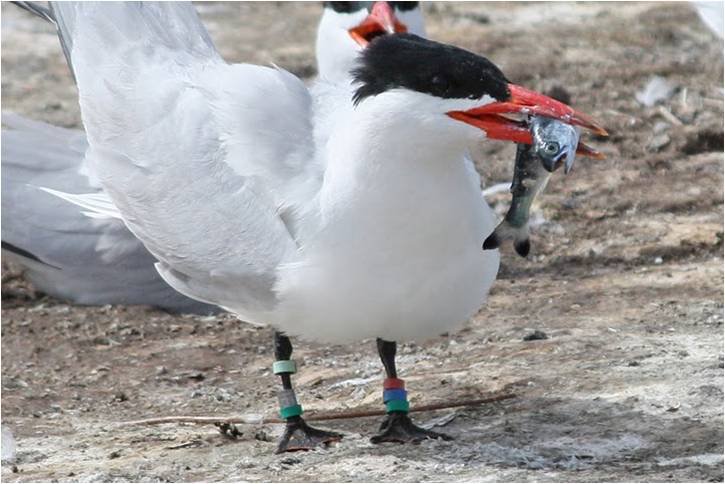Goose Island Terns Consumed Fewer Fish in 2014
Efforts to move terns away from ESA-listed steelhead are encouraging
- February 17, 2015
- John Harrison

Predation by Caspian terns on juvenile salmon and steelhead is a problem in the Columbia River estuary, but that’s not the only place. It’s also a problem in the mid-Columbia area of central Washington, where it's causing the Grant County Public Utility District to fail to meet a survival standard for juvenile steelhead at its two hydroelectric dams, Priest Rapids and Wanapum. Upper Columbia steelhead are listed as an endangered species under the federal Endangered Species Act.
It’s both ironic and frustrating, Grant PUD officials told the Council at a meeting this month in Portland. Frustrating because the PUD does not have bird-management authority, and ironic because juvenile steelhead survival at the dams is excellent. While the utility meets the survival standard for upper Columbia spring Chinook, also an endangered species, the utility misses the standard for steelhead because the birds pick off so many fish in the river.
In response, Grant is paying $2 million per year into a mitigation fund to support federal agencies as they work to address the predation problem, primarily through techniques to prevent the birds from nesting.
“We could spend a lot more at the concrete and not increase survival,” said Chuck Berrie, Grant PUD assistant general manager. “Focusing on avian predation is the single most important and cost-effective thing we can do to reduce the impacts on endangered species of fish.”
Caspian terns nesting on Goose Island in Potholes Reservoir, which is east of the Columbia near Moses Lake, Washington, annually consume an average of 15.7 percent of the ESA-listed steelhead smolts (and 2.5 percent of upper Columbia spring Chinook smolts) as they migrate down the river to the ocean. Efforts to discourage nesting in 2014 were encouraging. Fewer terns nested on Goose Island, and there was a corresponding significant reduction in predation by Goose Island terns on spring Chinook and steelhead. But as the number of nests declined on Goose Island, the number increased elsewhere in central Washington. Increased predation by terns from those colonies slightly offset benefits from the smaller Goose Island tern colony in 2014, the PUD reported.
“Terns eat fish. That’s not the problem,” said Curt Dotson, special projects manager for the utility. “The problem is they're eating an endangered species. So we need to move them to a place where they don’t impact endangered species.”
Tern habitat is being constructed by the Corps of Engineers outside the Columbia River Basin in southern Oregon and on Don Edwards National Wildlife Refuge in south San Francisco Bay in California in the hope of attracting birds as they return in the spring from their wintering areas in Mexico.



